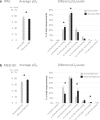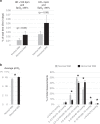Early oxygen levels contribute to brain injury in extremely preterm infants
- PMID: 33753894
- PMCID: PMC7984503
- DOI: 10.1038/s41390-021-01460-3
Early oxygen levels contribute to brain injury in extremely preterm infants
Abstract
Background: Extremely low gestational age newborns (ELGANs) are at risk of neurodevelopmental impairments that may originate in early NICU care. We hypothesized that early oxygen saturations (SpO2), arterial pO2 levels, and supplemental oxygen (FiO2) would associate with later neuroanatomic changes.
Methods: SpO2, arterial blood gases, and FiO2 from 73 ELGANs (GA 26.4 ± 1.2; BW 867 ± 179 g) during the first 3 postnatal days were correlated with later white matter injury (WM, MRI, n = 69), secondary cortical somatosensory processing in magnetoencephalography (MEG-SII, n = 39), Hempel neurological examination (n = 66), and developmental quotients of Griffiths Mental Developmental Scales (GMDS, n = 58).
Results: The ELGANs with later WM abnormalities exhibited lower SpO2 and pO2 levels, and higher FiO2 need during the first 3 days than those with normal WM. They also had higher pCO2 values. The infants with abnormal MEG-SII showed opposite findings, i.e., displayed higher SpO2 and pO2 levels and lower FiO2 need, than those with better outcomes. Severe WM changes and abnormal MEG-SII were correlated with adverse neurodevelopment.
Conclusions: Low oxygen levels and high FiO2 need during the NICU care associate with WM abnormalities, whereas higher oxygen levels correlate with abnormal MEG-SII. The results may indicate certain brain structures being more vulnerable to hypoxia and others to hyperoxia, thus emphasizing the role of strict saturation targets.
Impact: This study indicates that both abnormally low and high oxygen levels during early NICU care are harmful for later neurodevelopmental outcomes in preterm neonates. Specific brain structures seem to be vulnerable to low and others to high oxygen levels. The findings may have clinical implications as oxygen is one of the most common therapies given in NICUs. The results emphasize the role of strict saturation targets during the early postnatal period in preterm infants.
© 2021. The Author(s).
Conflict of interest statement
The authors declare no competing interests.
Figures





Similar articles
-
Continuous Application of Closed-Loop FiO2-Control in Extremely Preterm Infants: A Matched Cohort Single-Center Study.Pediatr Pulmonol. 2025 May;60(5):e71122. doi: 10.1002/ppul.71122. Pediatr Pulmonol. 2025. PMID: 40344397 Free PMC article.
-
Effects of closed-loop automatic control of the inspiratory fraction of oxygen (FiO2-C) on outcome of extremely preterm infants - study protocol of a randomized controlled parallel group multicenter trial for safety and efficacy.BMC Pediatr. 2019 Oct 21;19(1):363. doi: 10.1186/s12887-019-1735-9. BMC Pediatr. 2019. PMID: 31630690 Free PMC article.
-
Observing the resuscitation of very preterm infants: are we able to follow the oxygen saturation targets?Resuscitation. 2013 Aug;84(8):1108-13. doi: 10.1016/j.resuscitation.2013.01.025. Epub 2013 Jan 29. Resuscitation. 2013. PMID: 23376585
-
Oxygen saturation targets in neonatal care: A narrative review.Early Hum Dev. 2024 Dec;199:106134. doi: 10.1016/j.earlhumdev.2024.106134. Epub 2024 Oct 28. Early Hum Dev. 2024. PMID: 39481153 Review.
-
Oxygen saturation targeting by pulse oximetry in the extremely low gestational age neonate: a quixotic quest.Curr Opin Pediatr. 2017 Apr;29(2):153-158. doi: 10.1097/MOP.0000000000000458. Curr Opin Pediatr. 2017. PMID: 28085683 Free PMC article. Review.
Cited by
-
Cerebral oximetry monitoring versus usual care for extremely preterm infants: a study protocol for the 2-year follow-up of the SafeBoosC-III randomised clinical trial.Trials. 2023 Oct 7;24(1):653. doi: 10.1186/s13063-023-07653-x. Trials. 2023. PMID: 37805539 Free PMC article.
-
[Repair effect of different doses of human umbilical cord mesenchymal stem cells on white matter injury in neonatal rats].Zhongguo Dang Dai Er Ke Za Zhi. 2024 Apr 15;26(4):394-402. doi: 10.7499/j.issn.1008-8830.2310081. Zhongguo Dang Dai Er Ke Za Zhi. 2024. PMID: 38660904 Free PMC article. Chinese.
-
The application of magnetic susceptibility separation for measuring cerebral oxygenation in preterm neonates.Pediatr Res. 2025 Mar 19. doi: 10.1038/s41390-025-03966-6. Online ahead of print. Pediatr Res. 2025. PMID: 40108431
-
White Matter Injury in Preterm Infants: Pathogenesis and Potential Therapy From the Aspect of the Gut-Brain Axis.Front Neurosci. 2022 Apr 29;16:849372. doi: 10.3389/fnins.2022.849372. eCollection 2022. Front Neurosci. 2022. PMID: 35573292 Free PMC article. Review.
-
A Review on the Vagus Nerve and Autonomic Nervous System During Fetal Development: Searching for Critical Windows.Front Neurosci. 2021 Sep 20;15:721605. doi: 10.3389/fnins.2021.721605. eCollection 2021. Front Neurosci. 2021. PMID: 34616274 Free PMC article.
References
Publication types
MeSH terms
Substances
LinkOut - more resources
Full Text Sources
Other Literature Sources

